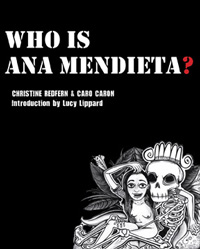

Knopf (CAN), hardcover, 9780676978933
Cuban American artist Ana Mendieta (1948-85) created beautiful, arresting and often shocking images during her lifetime. Sent to live in exile in America by her parents during childhood, Mendieta believed that her art was "a direct result of…having been torn away from my homeland during my adolescence….My art is the way I reestablish the bonds that tied me to the universe". While her photographs often pictured her naked and close to nature (covered in grass, for example) she also tackled the still controversial issue of violence against women. After a fellow student at the University of Iowa was raped, Mendieta created a performance piece in which she was photographed naked, bloodied and sprawled over a table as if she had just been sexually assaulted. It’s a shocking image designed to protest against the way the rape incident had been dealt with by the college authorities.
Who is Ana Mendieta? is the story of Mendieta's life, art and death. Told in two parts, the book seeks to reclaim Mendieta's oeuvre from what the authors consider to be the 'blind spot' in our collective memory that prevents women's creative achievements from being widely recognised and celebrated. Unfortunately if people do recognise Mendieta's name it's likely to be because of the manner of her death—she fell or was pushed from a New York apartment window; her husband, artist Carl Andre, was tried and acquitted of her murder.
The first part of the book is a biography in graphic novella form, a medium that Lucy R. Lippard describes in her introduction as 'ideally suited to insurrection'. The pages are a riot of black and white images, interpretations of Mendieta's work and words, re-creations of the art of her female contemporaries, and images depicting the misogynistic words and deeds of the art world. The pictures are upfront and in your face (possibly this isn't a book to read on public transport if you are easily embarrassed). My favourite is a crazed priest screeching about women being 'inferior and lustful'— he's so ridiculous!
This book is not a subtle investigation of the oppression of women and their art in late 20th century America. It feels like the point about misogyny in art is being rammed home at every opportunity, which perhaps isn't necessary in a book that I assume will be purchased by people with an existing interest in this area.
The second part of the book, called "Blind Spot", pushes this point even further. Blind Spot is a visual rendering of the sources used to inform part one of the book into a faux newspaper format. Redfern and Caron have placed "articles" drawn from the sources about Mendieta's life, death and work alongside stories of other women who have suffered violence at the hands of creative men (Adele Mailer, stabbed by her husband Norman; Joan Vollmer, killed by her husband William Burroughs), stories of women who have challenged contemporary norms, and tales of the suppression of female artists. Redfern and Caron clearly place Mendieta within a continuity of oppression and violence in which women's talents have been constantly denigrated and derided, something that, depressingly, carries on to this day (see V. S. Naipaul's recent comments about women authors' 'sentimentality' and ‘narrow view of the world'). I actually found this second section of the book to be more affecting, perhaps because I absorb information more easily through words rather than images. However, Blind Spot essentially reiterates the points made in the graphic novella and I'm not sure why both parts are needed. I would have preferred a more detailed exploration of Mendieta in either of the formats.
It's also worth mentioning that although Andre was cleared of murder, I came away from Who is Ana Mendieta? feeling that Redfern and Caron believe he was guilty of killing his wife. They suggest that he felt intimidated by her growing fame as his celebrity waned. The case documents have been sealed so I don't think this can be revisited, but next time I see Andre's work I will certainly have his relationship with Mendieta in my mind. This raises interesting questions about how an artist's deeds affect consideration of their art.
Overall I feel that Who is Ana Mendieta? is an interesting, if flawed, way of presenting an artist and the context within
which her creativity should be understood. I came to this book having never heard of Mendieta or many of the other women
referenced (to my shame, I recognised all of the men who are mentioned). I now have more knowledge about this period of art and
will look out for Mendieta's work in galleries.
